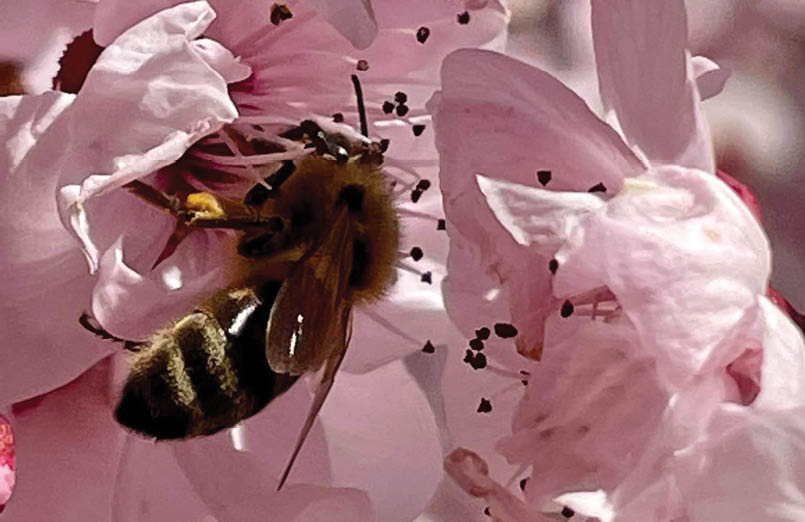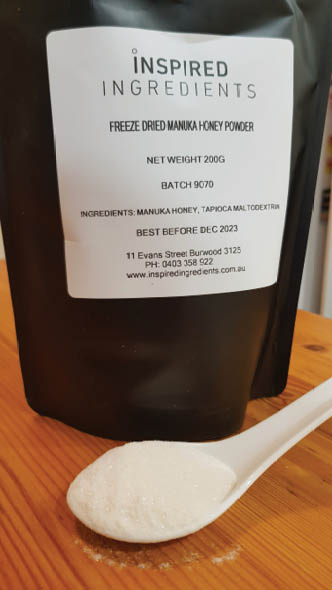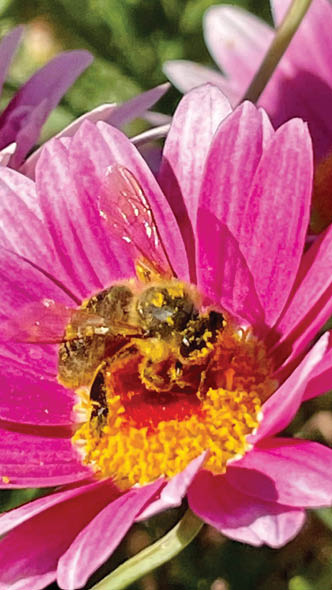

Oh Sweet Honey!
Sonya Muhlsimmer



I thought I would check out what Food Days Australia celebrates and get creative in the kitchen according to the food days. I came across the site National Food Day calendar.
Honey bee Mark Brown
62 | BWA October 2021

Honey bee Mark Brown
World Bee Day was on 20 May 2021 so why not celebrate bees and honey? Better late than never, and any day is a good day. Do you know how important bees are? They are very important, oh and the honey they make is so delicious and healthy for you, and they are worth talking about. So, why are bees so important? Well let me tell you why.
There are around 20,000 species of bees worldwide, one of which is the honeybee. Bees produce wax used for polish, candles, and skin care products, and they produce honey. Most importantly, bees are responsible for the most fundamental ecological processes - the pollination of plants. According to Science.org.au one-third of the global food production requires animal pollination and about 80-90 percent of this is done by honeybees. We would not have food like avocados, almonds, onion, sunflower, cucumbers, mangos, apples, asparagus and pumpkin and the list goes on. Bees are also worth around $4 to 6 billion per year for the Australian agricultural industry. Wow, I know, right.
But on a more sombre note, with little mainstream attention there has been a decline in bee population globally. Australia
is currently the only country not grappling with the Varroa mite that spreads viruses amongst the bee population. The decline is also caused by insecticides, fungicides, herbicides, fertilisers, habitat destruction and climate change. One thing we can do to help our bees is plant more flowers like Abelia, Bottlebrush, Daisies, Grevilia, Lavender, oh don’t forget to leave those Dandelions in the garden too. Bees need flowers for food and we need bees for our food, win-win.
Nutritionally, honey can change somewhat due to the season and processing techniques. Honey contains carbohydrates, enzymes, vitamins and minerals, antioxidants and lots of amino acids - the building blocks of protein which are essential in your diet. Honey can look and taste differently, and there are so many varieties of honey on the supermarket shelves. This is due to the type of flower or plant source, weather conditions and different botanical origins of where the bees collect the pollen.
You can buy raw honey, that is it has only been strained to remove the waxy bits, or more commonly available at the supermarkets, you buy processed honey. This honey has been heat-treated to kill off
BWA October 2021 | 63

any pathogenic bacteria that may be present. Unfortunately, during the processing of the honey, it loses some minerals and vitamins, so buy raw honey where you can from the beekeeper or corner stores who help the local folk. I buy my honey from my local fruit and veggie shop and they get the honey from a local beekeeper just up the road. The jar states who and where it comes from. I do realise not everyone will have the ability to buy like this, but it sure is a good way to support the local folk and bees, and the honey will do a lot less food miles as well. When I was at university, a few of my friends were studying entomology and on a regular basis I would take some containers in and give them to my friends, they would collect honey straight from their hives for me. My oh my it was nice honey.
Okay, I hear you ask, what has this got to do with hiking? So, on a hike take a small container of honey for your cups of tea. If you make scones you can drizzle some honey over them, or you can buy freeze-dried honey and bake a beeautiful cake. Get it, beeautiful …
Recently I bought 200 grams of freeze-dried Manuka Honey Powder, it cost $35, plus delivery … not cheap. This product however is not pure honey, it has been mixed with maltodextrin, a powder made from tapioca that acts as a filler, improves the texture and can help extend and stabilise the shelf life of a product. I bought it from Inspired Ingredients and this is what I did with it. Enjoy!

Honey bee Mark Brown
Freeze Dried Manuka Honey Powder Sonya Muhlsimmer
64 | BWA October 2021




At home preparationPlace all ingredients into the allocated bag, label the bag Honey Cake. Cut two pieces of greaseproof paper to fit the pan. Copy the At camp method and pack with the cake bag.
Method in campIn a bowl place the contents and ½ cup of water, stirring thoroughly to make a paste. Place a piece of grease proof paper in the bottom of the pan, spread the cake mix over the paper. Set the stove to a low to medium heat and cook for about 4-5 minutes or until bubbles appear and cover the surface, covered with a lid, if you have one. The cake may take a couple of minutes more to cook if not covered. Take off the heat, cover the top of the cake with the greaseproof paper and with your hand or small chopping board cover the top of the cake and flip the cake over. Place back in the pan and cook for about 2-3 minutes. Serve with some Mead if you must, yum!
Bag (honey cake mix)* Instead of honey powder, use 1 Tbsp of honey which has been stored in a small well sealed container. To ensure the container does not leak, place the container in a zip-lock bag.
Self raising flour
½ cup
Caster sugar
¼ cup
Milk powder
2 Tbsp
Egg powder
1 Tbsp
Honey powder*
2 Tbsp
Almond meal
¼ cup
Vanilla sugar
2 tsp
Water
½ cup
Honey – see note below
1 Tbsp
To read more about the author or find delicious recipes check xtremegourmet.com
Honey and Almond Cake
BWA October 2021 | 65